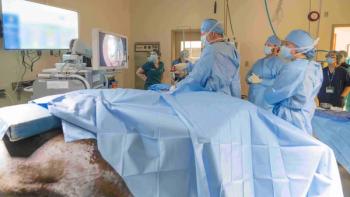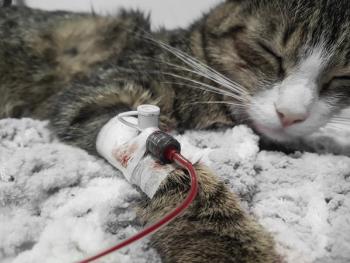
Cranial cruciate ligament tears: treatment options (Proceedings)
Conservative treatment of CCL rupture is the same as treatment for DJD: exercise to build muscle, weight control and medications such as NSAID's and Adequan. Surgery is the most effective treatment for CCL tear if done before DJD is established. Conservative treatment is indicated if surgery is not chosen by the owner because of cost or other reasons.
Conservative treatment of CCL rupture is the same as treatment for DJD: exercise to build muscle, weight control and medications such as NSAID's and Adequan. Surgery is the most effective treatment for CCL tear if done before DJD is established. Conservative treatment is indicated if surgery is not chosen by the owner because of cost or other reasons. The veterinarian may not offer surgery because DJD is too advanced (3-6 months after CCL rupture). CCL surgery stabilizes the stifle but does not correct DJD, therefore excessive lameness will persist due to DJD despite the surgery (so what does the surgery achieve?). Conservative therapy for CCL rupture is more likely to yield acceptable results in light weight dogs than large dogs. Two studies of dogs with conservative therapy for CCL rupture indicated ~ 80% of owners were satisfied with the results if the dogs weighed < 25 - 30 lbs, versus only 20% that were satisfied if their dogs were heavier. These studies do not indicate that conservative therapy yields as good a result as surgery in small dogs; it does not.
Lateral Suture (Flo), it's precursors and it's many derivations have been successfully used for CCL rupture in dogs since the mid 1950's. Dr. Flo established soon after her initial publication that braided polyester suture material had a high infection rate (~ 18%) and advocated monofilament material which has been the standard ever since. Monofilament material with a tensile strength of >20 lbs over the dog's body weight is typically used. Many derivations of exact placement of the lateral suture, single strand or double strand, knot type (slip, surgeons, Lark's head, crimp) are commonly used and all ostensibly yield satisfactory results. The factors which do appear to be critical are the a) location of the origin of the suture (at or near the lateral femorofabellar ligament), b) insertion of the suture (immediately distal to the cranial aspect of the tibial plateau), and c) that the stifle be held in negative drawer sign and the tibia externally rotated while the suture is being tied. a) The author exposes the femorofabellar ligament via an approach between the lateral retinaculum and joint capsule and elevating a slip of the gastrocnemius muscle that covers the ligament. Blindly placing a needle around the femorofabellar ligament may miss a large percentage of the ligament, and placing a needle around the fabella is typically a misconception (the needle slips off either proximal or distal to the fabella). An alternative, which is necessary if the femorofabellar ligament ruptures, is to place a suture holding bone anchor adjacent to the femorofabellar ligament. b) Numerous studies have demonstrated that placement of the hole in the tibia (to attach the lateral suture) is critical. The hole needs to be as near the natural insertion of the CCL, which is between the cranial intermeniscal ligament and the tibial eminences, as possible. Placement of the hole more cranial or more distal on the tibial plateau will create a cam effect that cyclically stretches and relaxes the lateral suture until it breaks. For practical purposes, the hole should be immediately under the tibial plateau adjacent to the muscular groove for the long digital extensor tendon.
Tight Rope is a modification of the lateral suture principles using FiberTape®. The material has extremely strong tensile strength and has been used extensively in human shoulder surgery. The placement technique is unique, using bone tunnels in the femur and tibia, and metalic buttons as anchor points. The procedure can be performed via limited incisions. FiberWire®, the strands composing FiberTape® has been used in various patterns and modifications of the lateral suture technique. The poor knot security of FiberWire® is a limitation.
Tibial Plateau Leveling Osteotomy (TPLO) is ostensibly the most common surgical procedure for CCL rupture used by A.C.V.S. Diplomates. The goal of TPLO is to eliminate cranial tibial thrust, which is the instability that occurs when a dog walks. TPLO does not eliminate cranial drawer sign, which does not occur when a dog walks. TPLO has the distinct advantage over techniques like lateral suture that once the osteotomy heals the instability can not return. Lateral suture, and other methods that use synthetic or graft materials, can break allowing the instability to return. TPLO has a track record of thousands of surgeries with a very good success rate.
Tibial Tuberosity Advancement (TTA), like TPLO, uses osteotomy to stop cranial tibial thrust. Ostensibly TTA is not as commonly used as TPLO.
Other surgical techniques for stabilization of CCL rupture are numerous, and can be used alone or in combinations. Imbrication of the lateral joint capsule and retinaculum are common and advisable additions to craniolateral approaches used for CCL stabilization techniques. Four in one, over-the-top techniques using fascia lata grafts, various synthetic materials are among the techniques used in the past but are infrequently used currently. The goal is to obtain good long term results on a high percentage basis, and any technique which accomplishes this on a consistent basis for a given surgeon is acceptable.
Newsletter
From exam room tips to practice management insights, get trusted veterinary news delivered straight to your inbox—subscribe to dvm360.




